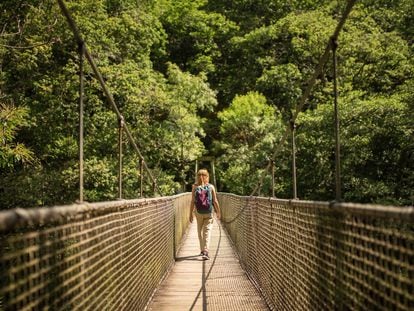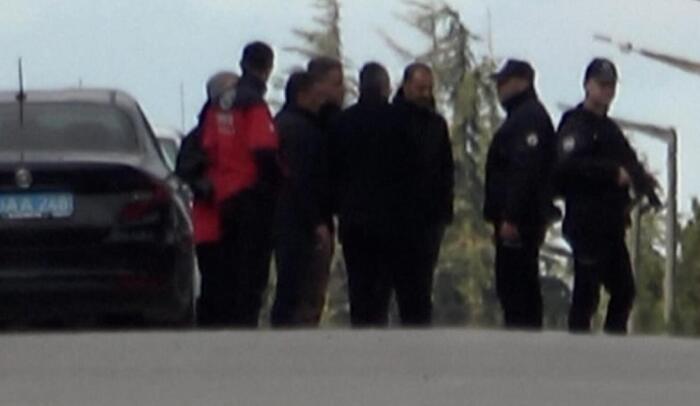The normal thing when someone asks me about excursions in the surroundings of Oviedo is that I answer Santa María del Naranco and San Miguel de Lillo.
The two great references of the Asturian pre-Romanesque.
And it is true, these jewels of early medieval Asturian art are two places to visit, yes or yes, when traveling to the capital of Asturias.
But they are no longer the only ones.
One of the most recent proposals is on Mount Naranco itself, the mythical peak for cycling fans and the green lung of Oviedo full of a multitude of possibilities to explore on foot or by bicycle.
This mountain, six kilometers long and just over 600 meters high, crowned since the eighties by a gigantic statue of the Sacred Heart, was the front line on which it was stuck for more than a year, since the summer of the Civil War. from 1936 to the autumn of 1937, the contest between the Francoist rebels and the Republican troops who were trying to take the city.
Oviedo was, thanks to a stratagem of the colonel who directed the plaza in that summer of 1936, the only Asturian city that did not remain on the side of the legitimate government.
A desperate situation for the Republicans, who tried at all costs to recover it.
They were about to do so had it not been for the fact that Franco sent a column from A Coruña, made up, above all, of Moroccans from the Regulares tabors and legionaries.
More information
My 17 secret places in Spain, one by autonomous community
Mount Naranco, due to its strategic position over Oviedo, became hell for both sides, with a fierce fight that produced thousands of deaths in one year.
At the top were the Moroccans, who dug trenches, erected casemates and machine gun nests.
On the opposite hill, a little lower, were the Republicans, who likewise dug trenches and erected casemates, bunkers, and machine gun positions.
The fight was cruel and merciless, no prisoners were taken.
Thousands of howitzers and projectiles of all kinds exploded on the slopes dominated by both sides, without the positions advancing even one meter.
Historical photo of Moroccan troops in the trenches at the top of Naranco (Asturias).
Many of the remains of that trench battle have now been valued and form the route of the Civil War in Oviedo, a new offer with which the City Council wants to diversify tourist visits to the city and which is having great success.
Like everything related to war or war tourism, a type of activity that has been in operation for a long time in emblematic places of World War II, such as the Normandy memorials and cemeteries, Omaha beach or the Atlantic Wall of Audinghen , all in France.
"We have registered more than a hundred vestiges of fortifications in the immediate surroundings of the city," Alfonso Fanjul, an archaeologist specializing in this tragic period in recent Spanish history and advisor to the Oviedo City Council, tells me as we walk through a stretch of trench in zigzag that appeared in a very good state of conservation just a few meters from the Sacred Heart that dominates the Naranco.
“But most of them are in poor access conditions or have arrived semi-destroyed, since many people took the opportunity to remove the iron from the concrete structures to sell them as scrap during the postwar period.
Pico Paisano trench, on Mount Naranco (Oviedo).
In 2012, Fanjul directed the first archaeological excavations carried out in Asturias on the Civil War and is enthusiastic about the amount of material that is appearing in the excavations, despite the fact that they have barely advanced a few meters.
"Not only war material has appeared, but also personal belongings of the soldiers who fought on both sides and which give us fabulous information to reconstruct that period," he details.
Among the most unusual finds, a small cut-glass bottle of women's perfume, made in Valencia in 1930. When I ask him what an object like that was doing in an environment like trench warfare, he shrugs and smiles.
Would a soldier carry it with him to remember his beloved as bombs fell and machine-gun fire swept through the trenches?
We will never know.
All these objects will be put in value and one day they will occupy showcases of a museum.
For now, visitors can descend into one of the darkest pages in recent Spanish history with the guided tours by Alfonso Fanjul that the City Council offers on Sundays in spring and summer to these two trenches and the four casemates of Mount Naranco. .
The explosives factory that planted trees
At the other end of the valley, to the south of the city, the people of Oviedo have found another gift of nature.
Or, in this case, the gunpowder and dynamite industry.
In 1865, the Belgian engineer Dionisio Thiry founded an explosives factory on land on the outskirts of Oviedo to serve the growing Asturian mining industry.
The La Manjoya Explosives Society became an industrial emporium in which some 1,200 people worked.
To prevent uncontrolled deflagrations (something that, apparently, was more common than expected: it is estimated that some 140 workers died throughout its history due to fortuitous explosions) various actions were carried out, from thick concrete walls to the door of each warehouse to the plantation of a 30-hectare forest of native and foreign species that surrounded the facilities so that in the event of an accident the trees would cushion the shock wave.
At first, exotic species such as redwoods were planted, but in the end it was seen that the only ones that took root well were the native ones, the Atlantic forest.
The landscape of the La Zoreda forest, planted by the La Manjoya Explosives Society. Paco Nadal
La Manjoya closed in the 1990s, with the decline of mining.
The factory and all the annexed buildings, which included accommodation for the engineers and managers, a church and many buildings that could have been reused for other purposes, were razed and an urban expansion of Oviedo was projected on these lands which, with the arrival of the 2008 crisis was left unfinished.
But the entire vast forest reserve, and what it contained, was left there, forgotten.
"In principle, the land is closed and all industrial structures are completely abandoned," Alfonso Fanjul tells me, who has also participated in the inventorying and cataloging of the industrial heritage of the La Zoreda forest, as the area is known. and who accompanies me to visit her.
“The good thing is that this also makes it an unknown area in Oviedo, because first it was private and then, a pure abandonment.
People had no intention, no interest, in visiting that degraded sector of the city”.
In 2019, the City Council managed to recover the land to create a peri-urban park, something that had already been attempted shortly after the factory closed.
The idea was to take advantage of those 30 hectares of Atlantic forest attached to the urban environment of Oviedo as another offer of recreation and leisure for citizens.
Walking the paths of La Zoreda right now produces mixed feelings.
You submerge yourself under a green canopy of authentic Atlantic oak, beech and chestnut forest, some of which are incredibly large, and you believe you are in a primary forest of the Atlantic mountain range.
However, it is a false forest, a forest that was not there before and that was created by man.
But given its curious origin, it looks like a real forest.
It is also surprising that at times you look to the side and only see virgin nature;
you turn your head to the other and see the motorway and the white buildings of the unfinished urbanization of La Zoreda.
A strange place, but a privilege for a city like Oviedo that already had a lot of green around it but that can now boast of also having one of the largest peri-urban parks in Spain.
Yes, inconclusive.
Because among those hundred-year-old trees, ruins, walls full of graffiti, abandoned facilities and much still to be cleaned are mixed.
La Zoreda is a project as ambitious as it is young, where almost everything remains to be done.
Guided tour of the La Zoreda forest, on the outskirts of Oviedo.Alfonso Fanjul
"A great job of recovering the forest has already been done," explains Fanjul as we continue along one of the paved paths.
“You see this where we are right now, because the road and the asphalt were invisible from the amount of scrub and undergrowth that had grown in all these years.
It was a hell of a job cleaning it up and leaving it as you see it now.
Right now the project is in a phase of putting value on some of the 70 abandoned buildings that we have cataloged within the park, from nitroglycerin laboratories to workshops where the women loaded the cartridges or the warehouses where the final explosive was accumulated.
Many of them are underground.
We have cataloged facilities from 1870 to 1990. In this sense, it is like a large industrial archaeological park, possibly one of the largest in Spain,
not only because of the dimensions but also because of the number of buildings that can be observed in relation to an industry as specialized as that of explosives.
At the moment, only one of them can be visited, but the idea is to value several more by conditioning the access”.
If the walk has made you hungry, on the edge of the forest -and without any relation to the old factory- you will find the Castillo del Bosque La Zoreda, a 20th century mansion in the form of a historicist fortress that was built by a wealthy local and It has been converted into a five-star hotel with a magnificent restaurant.
Rest for the body after an exhausting walk through the industrial and war history of Oviedo.
View this post on Instagram
A post shared by Hotel Castillo de la Zoreda (@castillozoreda)
Practical data
There are guided visits to both archaeological parks in the surroundings of Oviedo every Sunday from April 23 to September 29, both inclusive.
The one in the La Zoreda park starts at 12:00 in the outdoor
parking lot
of the Castillo de La Zoreda restaurant.
No reservation is necessary.
The route of the Civil War in Naranco leaves at five in the afternoon from the base of the monument to the Sacred Heart, at the top of Naranco.
In this case, places are limited and reservations must be made by phone or WhatsApp (679 07 90 76), during business hours.
Both visits are free.
You can also follow Paco Nadal on Spotify, Instagram, TikTok, YouTube and Twitter.
And listen to him every Friday, at 7:00 p.m., with Carles Francino on
La Ventana
, on Cadena SER.
Subscribe here to the
El Viajero newsletter
and find inspiration for your next trips on our
,
and
Instagram accounts
.







